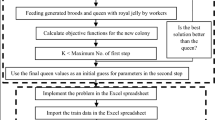Abstract
Artificial neural networks (ANNs), due to their outstanding capabilities for modeling complex processes, have been successfully applied to a variety of problems in hydraulics. However, one of the major criticisms of ANNs is that they are just black-box models, since a satisfactory explanation of their behavior has not been offered. They, in particular, do not explain easily how the inputs are related to the output and also whether the selected inputs have any significant relationship with an output. In this paper, a perturbation analysis for determining the order of influence of the elements in the input vector on the output vector is discussed. The analyses of the results suggest that each variable in the input vector (d 50/d 0, F 0, H/d 0, σg, and W 0/d 0) influences the depth of scour in different ways. However, the magnitude of the influence cannot be clearly quantified by this approach. Further it adds that the selection of input vector based on linear measures between the variables of interest, which is commonly employed, may still include certain spurious elements that only increase the model complexity.





Similar content being viewed by others
References
Alavi AH, Gandomi AH (2011) Prediction of principal ground-motion parameters using a hybrid method coupling artificial neural networks and simulated annealing. Comput Struct Elsevier 89(23–24):2176–2194
Azamathulla HMd, Haque MA (2012) Prediction of scour depth at culvert outlets using gene-expression programming. Int J Innov Comput Inform Control 8(7B):5045–5054
Azamathulla HMd, Ghani AAb (2011) An ANFIS-based approach for predicting the scour depth at culvert outlet, ASCE. J Pipeline Syst Eng Pract 2(1):35–40
Azamathulla HMd, Ghani AAb, Zakaria NA, Chang CK, Leow CS (2008) Knowledge extraction from trained neural network scour models. Mod Appl Sci Can 2(4):52–62
Azmathullah HMd, Deo MC, Deolalikar PB (2005) Neural networks for estimation of scour downstream of ski-jump bucket. J Hydraul Eng ASCE 131(10):898–908
Benitez JM, Castro JL, Requena I (1997) Are artificial neural networks black boxes? IEEE Trans Neural Netw 8(5):1156–1164
Castro JL, Mantas CJ, Benitez JM (2002) Interpretation of artificial neural networks by means of fuzzy rules. IEEE Trans Neural Netw 13(1):101–116
Eberhart RC, Dobbins RW (1990) Neural network PC tools: a practical guide. Academic, New York
Gandomi AH, Alavi AH (2011) Applications of computational intelligence in behavior simulation of concrete materials. In: Yang XS, Koziel S (eds) Chapter 9 in Computational optimization and applications in engineering and industry. Springer, New York SCI, vol 359, pp 221–243
Gandomi AH, Yang XS, Talatahari S, Alavi AH (2013) Metaheuristic applications in structures and infrastructures. Elsevier, Amsterdam
Ho YC (1992) Perturbation analysis: concepts and algorithms.In: Arlington VA, Swain JJ, Goldsman D, Crain RC, Wilson JR (eds) Proceedings of the 1992 winter simulation conference, pp 231–240
Jain A, Sudheer KP, Srinivasulu S (2004) Identification of physical processes inherent in artificial neural network rainfall runoff models. Hydrol Process 118(3):571–581
Jingsheng J (2002) Clustering technique for evaluating and validating neural network performance. J Comput Civ Eng 16(2):152–155
Lange NT (1999) New mathematical approaches in hydrological modeling-an application of artificial neural networks. Phys Chem Earth 24(1&2):31–35
Lim SY (1995) Scour below unsubmerged full flowing culvert outlets. Proc Inst Civil Eng Water Marit Energy 112(2):136–149
Lozowski A, Cholewo TJ, Zurada JM (1996) Crisp rule extraction from perception network classifiers. In: Proceedings of the IEEE international conference on neural networks. Plenary, Panel, and Special Sessions, Washington, DC, pp 94–99
Maier HR, Dandy GC (2000) Neural networks for the prediction and forecasting of water resources variables: a review of modelling issues and applications. Environ Model Softw 15(1):101–124
Paliwal M, Kumar UA (2011) Assessing the contribution of variables in feed forward neural network. Appl Soft Comput 11:3690–3696
Schmitz GPJ, Aldrich C, Gouws FS (1999) ANN-DT: an algorithm for extraction of decision trees from artificial neural networks. IEEE Trans Neural Netw 10(6):1392–1401
Stewart I (1989) Does God play dice? The mathematics of chaos. Blackwell, Cambridge
Sudheer KP (2005) Knowledge extraction from trained neural network river flow models. ASCE, J Hydrol Eng 10(4):264–269
Sudheer KP, Jain A (2004) Explaining the internal behaviour of artificial neural network river flow models. Hydrol Process 118(4):833–844
Tickle AB, Andrews R, Golea M, Diederich J (1998) The truth will come to light: directions and challenges in extracting knowledge embedded within trained artificial neural network. IEEE Trans Neural Netw 9(6):1057–1068
Wilby RL, Abrahart RJ, Dawson CW (2003) Detection of conceptual model rainfall-runoff processes inside an artificial neural network. Hydrol Sci J 48(2):163–181
Yang XS, Gandomi AH, Talatahari S, Alavi AH (2012) Metaheuristis in water, geotechnical and transportation engineering. Elsevier, Amsterdam
Acknowledgments
The authors gratefully acknowledge the financial support from the International Foundation for Science (IFS) and Organisation for the Prohibition of Chemical Weapons (OPCW) as research grant (Grant no. W/5073-1). Authors also express their sincere gratitude to Universiti Sains Malaysia (USM) and Ministry of Higher Education (MOHE), Malaysia for allowing necessary financial support through research grants (USM Short Term Grant, Code no P3665; and Explanatory Research Grant Scheme-ERGS, code no. X0043).
Author information
Authors and Affiliations
Corresponding author
Rights and permissions
About this article
Cite this article
Azamathulla, H.M., Haque, A.A.M. Knowledge extraction from trained neural network scour model at culvert outlets. Neural Comput & Applic 23, 2137–2141 (2013). https://doi.org/10.1007/s00521-012-1164-2
Received:
Accepted:
Published:
Issue Date:
DOI: https://doi.org/10.1007/s00521-012-1164-2




